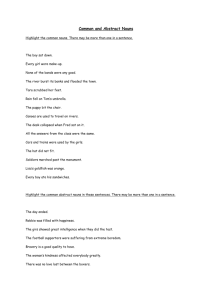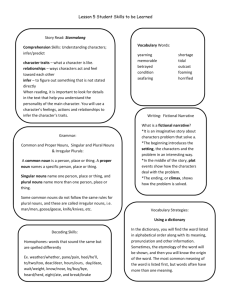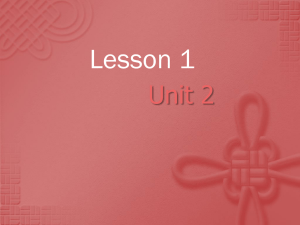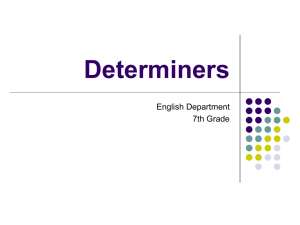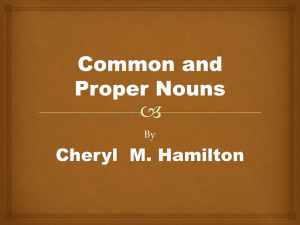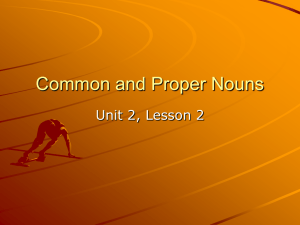WHAT IS A NOUN?
advertisement
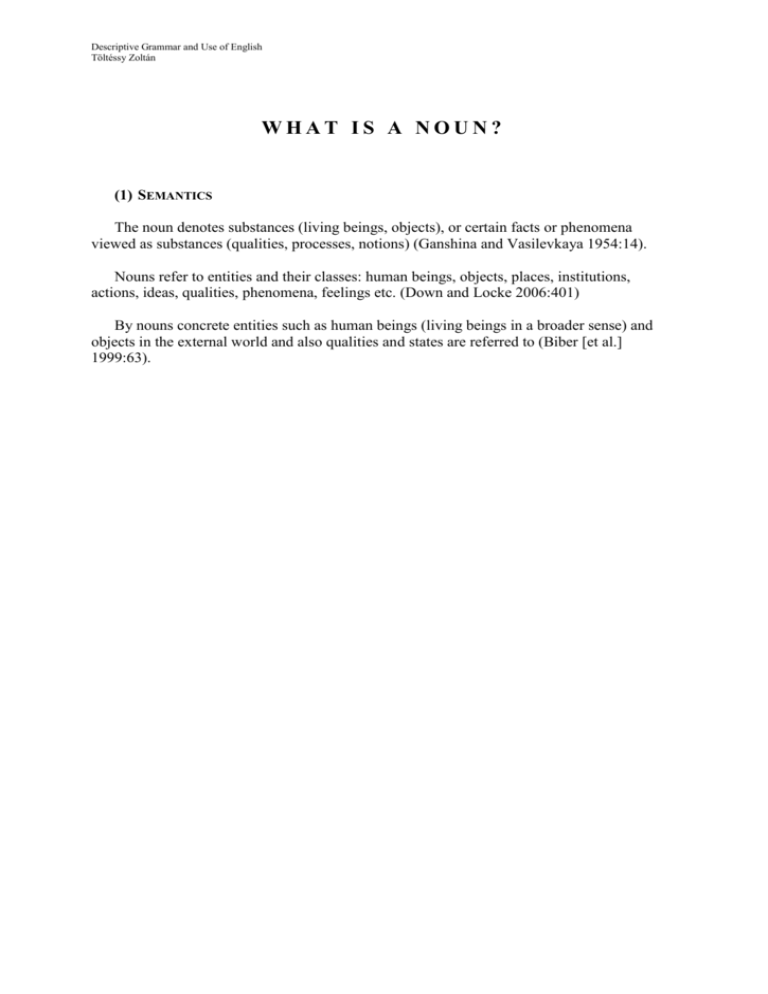
Descriptive Grammar and Use of English Töltéssy Zoltán WHAT IS A NOUN? (1) SEMANTICS The noun denotes substances (living beings, objects), or certain facts or phenomena viewed as substances (qualities, processes, notions) (Ganshina and Vasilevkaya 1954:14). Nouns refer to entities and their classes: human beings, objects, places, institutions, actions, ideas, qualities, phenomena, feelings etc. (Down and Locke 2006:401) By nouns concrete entities such as human beings (living beings in a broader sense) and objects in the external world and also qualities and states are referred to (Biber [et al.] 1999:63). Descriptive Grammar and Use of English Töltéssy Zoltán Nouns may be classified logically into the following categories⃰: Diagram 1 Semantic classification of nouns (Budai 1986:323) NOUNS Concrete Common Class ⃰ Individual man, girl, book, house Abstract beauty, time, length, choice Proper John, Washington, the Thames, the High Tatras Material water, iron, wool, glass Collective crowd, class, company, family Although no detailed explanation can be read in either edition, the two tables above and below may seem contradictory but they show how the same linguistic phenomenon/factor can be viewed differently by the same author. (tz) Descriptive Grammar and Use of English Töltéssy Zoltán Nouns may be classified logically into the following categories: Diagram 2 Semantic classification of nouns (Budai 2009:272) NOUNS Concrete Common Class Material water, iron, wool, glass Abstract beauty, time, length, choice Proper John, Washington, the Thames, the High Tatras Individual girl, book, house, man Collective crowd, class, company, family Descriptive Grammar and Use of English Töltéssy Zoltán (2) PRONUNCIATION There are some cases in which the shift of stress denotes the parts of speech which a word may belong to, as follows: Table 1 Shift of stress in different parts of speech Verb Noun /rɪˈkɔːd/ /ˈrekɔːd/ /ɪnˈkriːs/ /ˈɪnkriːs/ /ɪnˈsʌlt/ /ˈɪnsʌlt/ /ɪkˈspɔːt/ /ˈekspɔːt/ /dɪˈzɜːt/ /ˈdezɜːt/ The change of part of speech may be indicated by the change of voice, as shown below: Table 2 Change of voice in different parts of speech Verb Noun /ədˈvaɪz/ /ədˈvaɪs/ /briːð/ /breθ/ /haʊz/ /haʊs/ /maʊð/ /maʊθ/ /waɪv/ /waɪf/ Descriptive Grammar and Use of English Töltéssy Zoltán (3) SYNTACTIC FUNCTION Nouns turn up in a sentence as a subject, subject complement, object, object complement and as part of a prepositional phrase (prepositional object). Table 3 Syntactic functions of a noun E x a m p l e s S y n t a c t i c f u n c t i o n s Where are the children? Kate is playing in the yard, Peter is studying in his bedroom. subject Mr Black has been appointed chief manager. subject complement Barack Obama was elected president in 2008. It was Thomas Alva Edison who invented the efficient light bulb. Mrs Smith sent his husband an urgent message. It was the staff meeting that nominated Mrs Taylor vicepresident. The tribe moved across the plain and settled at the foot of the hill about ten years ago. direct object indirect object object complement part of a prepositional phrase (4) MORPHOLOGY From the viewpoint of morphology English is a poor language. It results from its nature, namely English is a typical case of isolating tongues. It means that the majority of words are unanalysable. These words are simple like take, go, sit, quick, slow, high, red, eight, ten, eleven; and nouns such as book, thumb, tree, wood, timber, Earth etc. New nouns are created by connecting two nouns. This way compound nouns are introduced into language. E.g. bookkeeping and e-book; thumbnail, treetop, woodpecker, timberline, earthquake etc. There are many derivative affixes by means of which new form can be invented. Derivative nouns are created with prefixes, e.g. co-author, ex-minister, misconduct, counteraction, anticyclone etc.; with suffixes, e.g. teacher, hostess, majority, knighthood, friendship, marriage, darkness, cruelty, freedom etc. Descriptive Grammar and Use of English Töltéssy Zoltán As there is not any declension in English (except for the gentive ’s), uncountable nouns usually have a single form, countable nouns regularly have an extra stem+(e)s for the plural use. (5) GENDER Gender is a grammatical category, a feature of nouns in several languages. It has hardly anything to do with biology or biological sexes. As for linguistic and biological animacy, it is obvious that biological sexes and grammatical genders match up irregularly. Sex has to be differentiated from grammatical gender, which is a morphosyntactic category which flective languages have for keeping track for nouns. Sex is a semantic property in language; gender is a formal/coding property (Frawley 1992:99). (See Chapter (7) Cases and declension of nouns below.) There is no gender at all in Hungarian. Neither does Esperanto have gender in the case of nouns: all nouns end in –o, e.g. knabino ‘girl’, edzo ‘husband’, barilo ‘fence’. In this sense English nouns do not have gender, e.g. teacher GERMAN der Lehrer (masculine), die Lehrerin (feminine); ROMANIAN profesor (masculine), profesoară (feminine); SLOVAK učiteľ (masculine), učiteľka (feminine). (6) NUMBER English native speakers instinctively make a distinction with regard to how a referent is cognitively perceived: whether it is a discrete, countable entity, such as pig, or as an indivisible, noncountable mass entity, such as pork. This count‒mass is made in all languages. It cannot be assumed that particular items are conceptualised and lexicalised in the same way in different languages. E.g. news is a singular mass noun in English. By contrast in Spanish, noticia is a normal count noun as hír in Hungarian: una noticia, dos noticias, muchas noticias; egy hír, két hír, sok hír, hírek (respectively) (Down and Locke 2006:405). As regards concepts in human mind, there are bounded and unbounded entities. They have three distinct internal properties. Bounded and unbounded entities diverge on their internal homogeneity/heterogeneity, their expansibility and their replicability (Frawley 1992:83—5). Bounded entities have internal organisation. They can be considered to be composed of different parts and are thus heterogeneous. Because they have internal structure, they cannot be conceptually expanded or contracted without losing their status. They can be repeated. Bounded entities can incremented (the term introduced by Ronald W. Langacker is incrementation) in discrete units because the bounding serves to demarcate one unit from another. Descriptive Grammar and Use of English Töltéssy Zoltán Figure 1 Countable noun This key has a definite contour; its different parts functioning in different ways can be easily distinguished. It has two distinct parts, a bow and a blade. (This is the English way of thinking!) Figure 2 Figure 3 Nonexpansibility of a countable noun If a key is divided/broken into two parts, it will not work. Duplicability of a count noun It can be duplicated. By contrast, unbounded entities have no internal structure, they are internally undifferentiated. If an amount of this entity is subtracted, or more added for that matter, image of entity remains intact. There can be more or less of an unbounded entity because it is seemingly continuous (not breakable into separate parts), noncomposite (amorphous) and thus scalable. Figure 4 Uncountable noun Bounded entities are generally countable because they have a delimitation and thereby replicable. Therefore bounded entities tend to receive the morphological changes of number in whatever manner a language construes this formal device. In English, countability is associated with the indefinite article, numerals, the distributive quantifiers each and every, and pluralisation. Descriptive Grammar and Use of English Töltéssy Zoltán Unbounded entities tend to be uncountable or nonenumerable because of their continuousness and expansibility. (After all, how can nondelimited entities be enumerated when enumeration presupposes differentiation of the entities to be enumerated?) Unbounded entities therefore overwhelmingly tend to be marked differently in the number systems of languages. In English, mass nouns tend not to take the indefinite article, numerals and pluralisation. They tend to occur either with no marker or with nondistributive quantifiers like some, much and little. In English there are three numbers: singular (a book, some milk), dual (scissors, pants) and plural (two books). (7) CASES AND DECLENSION OF NOUNS Cases indicate the functional role of nouns (noun phrases) in relation to other words in a sentence (clause). German has four cases, Romanian has five cases, Russian six cases, Polish seven, and Lithuanian ten. (See Table 4 Cases of nouns in some European languages below.) Unlike many languages, there is not a system of declension of nouns in English. Nouns have only one form for all cases, e.g. accusative, dative etc. There is only one exception, in which the form of the noun takes the possible ’s ending but does not change. Thus all nouns have a common case both in singular and plural: a soldier’s duty, man’s liberty, the department’s homepage, women’s weekly, the children’s timetable, ladies’ dressing room, BA students’ English grammar An English noun in the common case may have all syntactic functions (nominative, accusative, preposition+accusative, dative ‘indirect object’) (Budai 2009:279). By contrast, Slavic languages and German have complicated systems of declension. (See Table 5 Declension in German below.) As regards Hungarian, grammar is not approached traditionally from the viewpoint of cases. Attempts have recently been made to work out a systematic case grammar of Hungarian. The linguist is Béla Korponay and his latest book on the topic is entitled A Hungarian—English case grammar ([Budapest] : ELTE Eötvös Kiadó, 2001, ISBN 963-463382-x). Descriptive Grammar and Use of English Töltéssy Zoltán Table 4 Cases of nouns in some European languages Romanian Russian Nominative Accusative Genitive Dative Instrumental C a s e s Polish German Lithuanian (Lithuanian declension) L a n g u a g e s Inessive (locative) (locative) Illative Allative Addessive Vocative Prepositional Locative Descriptive Grammar and Use of English Töltéssy Zoltán Table 5 Declension in German Irregular declension in German – Die starke Beigung Einzahl – Singular Der männlich Gender – Masculine Der sächlich Gender – Neuter Der weiblich Gender – Feminine Werfall – Nominative der Vater das Kind die Mutter Wenfall – Accusative den Vater das Kind die Mutter Wemfall – Dative dem Vater dem Kind(e) der Mutter Wesfall – Genitive/Possessive des Vaters des Kindes der Mutter Mehrzahl – Plural Der männlich Gender -- Masculine Der sächlich Gender – Neuter Der weiblich Gender – Feminine Werfall – Nominative die Väter die Kinder die Mütter Wenfall – Accusative die Väter die Kinder die Mütter Wemfall – Dative den Vätern den Kindern den Müttern Wesfall – Genitive/Possessive der Väter der Kinder der Mütter Notizen – Notes Descriptive Grammar and Use of English Töltéssy Zoltán BIBLIOGRAPHY Arkhadevskaya, K. A. [et al.]. (1975) English grammar through practice : (morphology). Moscow : Higher School. 207 p. ; 20 cm ISBN --- Biber, Douglas [et al.]. (1999) Longman grammar of spoken and written English. Harlow : Longman. xxviii, 1204 p. : ill. ; 24.6 cm ISBN 0-582-23725-4 Budai László. (1986) English syntax : theory and practice. 2. kiad. Budapest : Tankönyvkiadó. 640 p. : ill. ; 20 cm (Tanuljunk nyelveket!, ISSN 0133-1094) ISBN 963-17-9558-6 Budai László. (2009) BA students’ English grammar : theory and practice. Budapest : Osiris. 535 p. : ill. ; 23.7 cm (Osiris tankönyvek, ISSN ---) ISBN 978-963-276-036-0 Chalker, Sylvia and Weiner, Edmund. (1998) The Oxford dictionary of English grammar. Reissued, with corrections. London ; New York, Oxford University Press. x, 448 p. : ill. ; 19.6 cm (Oxford paperback reference, ISSN ---) ISBN 0-19-280087-6 Downing, Angela and Locke, Philip. (2006) English grammar : a university course. 2nd edition. London ; New York : Routledge. xxii, 610 p. ; 24.6 cm ISBN 0-415-28787-1 Frawley, William. (1992) Linguistic semantics. Hillsdale (NJ) : Laurence Erlbaum Associates. 533 p. : ill. ISBN 0-8058-1075-7 Ganshina, M. and Vasilevkaya, N. (1954) English grammar. 7th edition, revised. Moscow : Foreign Languages Publishing House. 471 p. ; 22.8 cm ISBN --‘Lithuanian declension.’ (2013) In: Wikipedia. <http://en.wikipedia.org/wiki/Lithuanian_declension> Last modified: 27-07-2013 Retrieved: 02-03-2014

